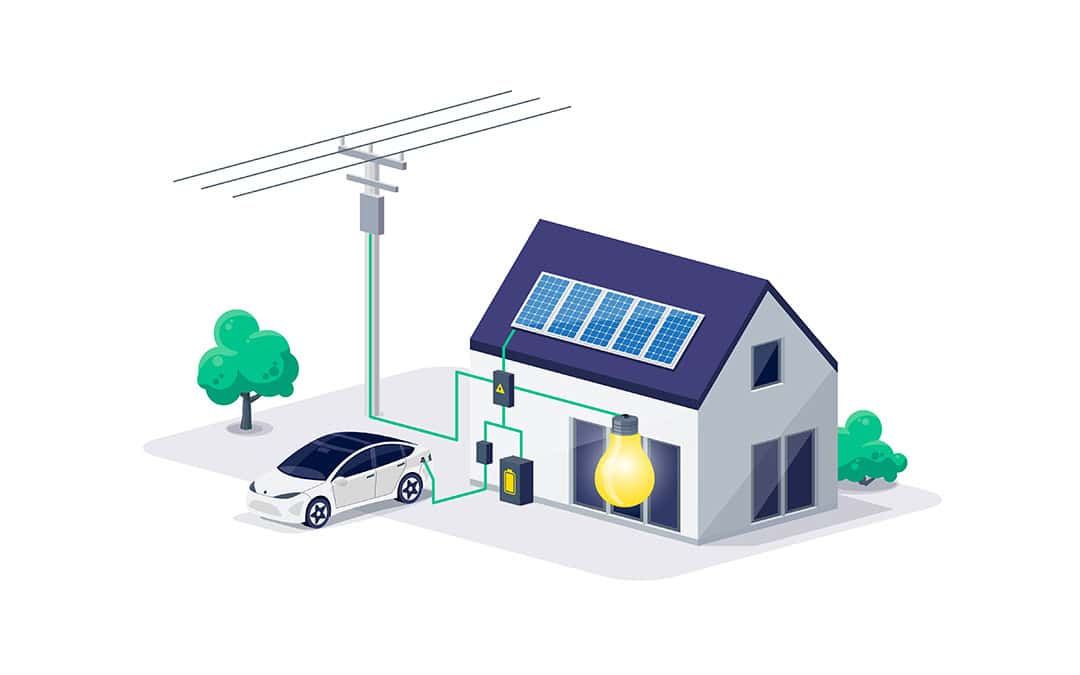Updated 04/02/2024: We’ve updated this guide with more information about how solar energy powers homes and how renewable energy is reshaping the United States.
Did you know 350 gigawatts of solar energy were installed globally in 2023? As more homeowners become aware of solar energy and its benefits, solar panels have become common on rooftops across the US. But how does solar work? How do solar systems create energy to power my home?
Keep reading as we answer “How does solar energy power your home?”
The Basics of a Solar Energy System
The components that make up a solar system come together to power your home in four easy steps:
- When sunlight strikes the solar panels, the energy is captured, creating a direct current (DC) that runs through a series of wires and conduits within the panel.
- The DC electricity is then transferred into an inverter and converted into alternating current (AC) electricity. This is the electricity that is used to power your home.
- The converted electricity is then sent to your electrical panel and distributed throughout your home – similar to how electricity flows from the utility grid for a pre-solar home.
- During the hot, summer months or when no one is home consuming any electricity being produced, you may create an excess of energy. Your solar system uses a meter that measures how much electricity you consume and how much is produced. Any excess is returned to the utility company for a set price per kilowatt-hour (kWh). This is known as Net Metering (NEM).
Now, let’s dive into the solar science behind these steps.
Solar Cell Technology
A solar system may seem complex at face value, but the components that make up a solar system are fairly easy to understand.
Solar panels are comprised of three main materials: silicon, metal, and glass.
Silicon is the main component of a solar panel and is used partly due to its long life span, and ability to optimize efficiency. This means that silicon solar panels work a little better.
Solar panels are layered with a layer of glass with an anti-reflective coating to guard the silicon cells, allowing light to produce energy. The solar cells, also called photovoltaic cells, absorb sunlight during the day hours.
A plastic or polymer frame houses the cells to help prevent premature breakdown, and the metal framing conceals the wiring throughout the panel. This backing is what installers use to attach your solar panels to your roof or ground mount system.
Once these panels capture solar rays, energy needs to be converted into a usable source for the home.
What Is a Solar Inverter?
A solar inverter, often referred to as the “brains” of a solar energy system, is a device that converts the DC energy from sunlight into a usable AC that powers your home. Over the years, the solar inverter has been greatly optimized into something far more efficient than just a conversion tool.
Many solar inverters are also being used to create a monitoring system, allowing homeowners to track their usage and production and ensure their panels operate at full capacity.
Data monitoring through an inverter allows homeowners to have full transparency of the production and status of their solar system. It can highlight any issues or concerns that would have been easily overlooked.
How Solar Powers Your Home
Once converted to AC energy, the sunlight captured through the panels is fed through a breaker box and dispersed throughout the home or business.
The total amount of energy produced depends on the number of panels installed within a system, the type of inverter used, and the efficiency rating of all aspects within the panel.
Homes that require more energy, such as an EV charger or hot tub, will need a larger system to supplement that usage. When considering solar, it’s best to consider all future energy needs to ensure that the solar system will continue to produce the right amount for your home.
Save More with Purelight Solar
When considering solar, it’s important to choose a company that offers the right warranties, the right support, and the right service. Every system from Purelight is backed by our 25 25-year performance guarantee, 20-year panel warranty, 10 10-year workmanship guarantee, and a team of expert in-house installers. Take our 30-second survey and see if your roof qualifies for simple, affordable solar with $0 money down!





